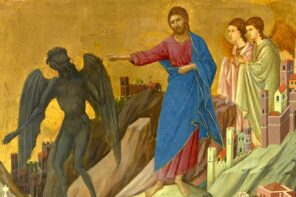Please note: spoilers ahead.
Stop me if you’ve heard this one: three evangelicals, an atheist, an ex-nun, and a rootworker walk into an exorcism. Fifty years after William Friedkin’s The Exorcist shocked America, director David Gordon Green has delivered a new entry to the franchise with Ellen Burstyn and Linda Blair reprising their roles from the original.
Friedkin’s film was a very Catholic story. William Peter Blatty was a Catholic and his 1971 novel The Exorcist was inspired by a Washington Post account of a Catholic exorcism. He was also tutored in demonology by his former teacher, Jesuit Thomas Bermingham, who didn’t want him to write “another Rosemary’s Baby.” Green’s film all but removes the Catholic Church: Despite overwhelming evidence that two young girls have been possessed, the diocese refuses to intervene, leaving two families and their neighbors to cobble together an ad hoc ritual using whatever spiritual traditions they’re familiar with. One consequence of Green’s choice is that audiences get a less patriarchal exorcism in which a lay Catholic woman and a female root worker pit their collective wisdom against a demon. But many horror critics disliked Green’s twist on the classic story, with some questioning whether it’s possible to tell a good Exorcist story without the Catholic Church.
Like all aspects of religious cultures, exorcism practices change over time and Green’s interfaith exorcism reflects changes that have occurred since the original. Rome now hosts ecumenical discussions about exorcism. (In fact, a Catholic diocese in 2023 denying an exorcism in a case this extreme is about as extraordinary as a diocese in 1973 allowing one.) Historically, at least in the West, the politics of exorcism shifted from uniting people around an individual, to uniting people around a particular church. Today, exorcism centers around different sorts of alignments, including political views (exorcists tend to be conservative) and attitudes toward the supernatural.
In the first century CE, exorcism signaled the charismatic authority of the exorcist. The gospel writers recorded Jesus casting out demons because this was evidence that he was the messiah. Similarly, figures like Apollonius of Tyana and Hanina ben Dosa were considered miracle workers with the power to perform exorcisms. Following the Protestant Reformation, Europe saw “the Golden Age of Demoniac.” Exorcisms were rampant and they became a way of showing which church had power over demons. A successful exorcism was no longer proof of an individual’s charisma, but a way of validating an entire religious community. This attitude toward exorcism continued into the twentieth century. The pamphlet Begone Satan! describes a Catholic exorcism that occurred in Earling, Iowa in 1928 and was one of Blatty’s influences for The Exorcist. That pamphlet describes a successful exorcism and attributes the victory to the entire Catholic community, lay Catholics as well as priests. Conversely, when Pentecostal missionary Lester Sumrall performed an exorcism in The Philippines in 1953, he used it as evidence that his faith had power over demons and Catholicism did not.
But at some point, what was at stake in exorcism began to shift again—at least in the popular, Western imagination. The alignment shifted from rivalries between churches to a battle between our disenchanted present and our spiritual past. Before The Exorcist used red font on a black background on its poster, this combination appeared on the 1966 issue of Time magazine asking, “Is God Dead?” In 1973, when audiences fainted and vomited their way through Friedkin’s film, psychologists clutched their pearls and described this as an eruption of magical atavism into what was supposed to be our modern secular society.
Psychologists regarded fear of demons as a Freudian “return of the repressed.” But many others felt Western civilization had lost something precious by turning the supernatural into an embarrassment and wanted to find it again. This may be why it’s virtually a requirement that exorcism movies open with a scene in Iraq, Africa, or some place where Westerners imagine there’s a more direct connection to the spirit world.
This idea can be found in theologian Rudolf Otto’s The Idea of the Holy (1917). Like Green’s film, Otto suggested there was some shared phenomenological reality buried behind the doctrines of different religions and that it could still be encountered “in remote corners of the Mohammedan and Indian world . . . in the streets of Magador and Marrakesh where religion shows itself alive as a naïve emotional force, with all its primal quality of impulse and instinct.” Green’s film pays homage to this tradition by setting the opening scene in Haiti just before the 2010 earthquake. (However, instead of portraying Haiti as a home base from which demons are unleashed on the West, the family receives a Vodou blessing that may have bestowed some supernatural protection.)
For those who subscribed to the Western “myth of disenchantment,” belief in the supernatural took precedence over denominational differences. Blatty famously wanted demons to exist because this would imply the materialist worldview he regarded as depressing is wrong. Furthermore, he didn’t believe the Catholic Church had a monopoly on the truth. In one interview he stated, “Catholicism is as close to the truth as any organized religion has come, and I look forward to the day when the more daring of the theoretical physicists nudge Catholicism into some sort of amalgamation with the philosophic insights of the Eastern religions.”
In the decade after The Exorcist, Ed and Lorraine Warren, the couple who inspired The Conjuring, began touring colleges around the country and giving lectures as Catholic demon busters. But they too demonstrated an ecumenical streak, with Ed Warren once stating, “I’ve worked with exorcists from every major religion . . . Usually they have no other title than monk, priest, rabbi, minister, or yogi, but they all seem to embody a combination of wisdom, kindness, and compassion that you don’t see in ordinary people.” Quotes like this suggest a spiritual community united not by its creeds or practices, but by a shared emphasis on the supernatural.
In recent years, this ecumenical approach to exorcism has taken a postmodern turn in which anything can be used to combat demons so long as it is subjectively regarded as sacred. In Green’s film, Chris MacNeil (Ellen Burstyn) rebukes the demon “in the name of all holy beings, including my daughter.” This oddly personal exorcism seems inspired by Grady Hendrix’s 2017 novel My Best Friend’s Exorcism, in which Hendrix’s teenage heroine watches an evangelical deliverance minister fail to cast a demon out of her friend before casting out the demon herself using a litany composed of cherished memories, inside jokes, and other “holy symbols” of their friendship. This theory of what exactly it is that repels demons happens to mirror contemporary academic debates about what exactly constitutes “religion.”
Indeed, while Friedkin’s film was about theodicy and “the mystery of goodness” (If supernatural evil existed, then so too must God), The Exorcist: Believer shifts the focus away from God and toward other dimensions of religion. A fallen nun named Ann (Ann Dowd) delivers several monologues suggesting religion is really about community and hope, not the competing truth claims of different traditions. On the one hand this formulation suggests that our connection to other people may be more important than our connection to God. On the other hand, this only raises the stakes when the people we care about most become possessed. Interestingly, one thing the two films do share is that the ritual of exorcism fails and expelling the demon ultimately requires a human sacrifice. After all, it’s still a horror movie.





